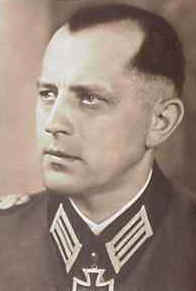| The following information is
presented as a general guide for re-enactors and Living Historians portraying German
soldiers of the 20th Century. The German soldier was subject to multiple intrusions
into his personal life, as well as several sets of orders and regulations.
While some practices may have been relaxed in the field, it behooves re-enactors in the
public eye to hold themselves to higher standards than may have been exhibited by those
they seek to portray. The
following are based on official regulations as well as informal common practice.
APPEARANCE
Male Haircuts
Several hairstyles were popular in the 20th Century, though
soldiers in uniform found themselves restricted to what they were permitted to do with
their hair. In all cases, hair was kept short, the basic standard being that it had
to be kept off the collar and off the ears. In general, extremely short hair styles,
as found favour in the 1980s and 1990s in modern militaries, the were not common during
the Second World War.
The following information from The Haircut Site gives some examples of what
would be considered acceptable or not. (Photos also reproduced from The Haircut
Site). As well, re-enactors should keep their hair a natural hue. Sideburns
are not mentioned, but should net extend past halfway down the earlobe; even better is to
have them cut in line with the top of the ear.
 |
According to The Haircut Site, the "Businessman's
Cut" is "cut long enough to be either parted or brushed back. The back and sides
may be tapered or slightly longer, and the hair is usually cut above the ears. This cut is
short, but not too short. It's suitable for even the most conservative occupations, and
versatile enough to wear differently in different circumstances." This style is acceptable for re-enactment, and will not make a re-enactor
stand out when he returns to his civilian life at the end of a weekend event. |
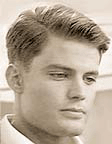 |
The Haircut Site defines the "Taper Cut" as
"the style of having the hair cut progressively shorter lower down towards the nape
of the head. This is generally done with electric clippers and gives a crisper, freshly
cut look. The degree of tapering can range from a slight taper to a style in which the
hair around the nape and around the ears is shaven." At left is Casper Van Dien
as he appeared in the movie "Starship Troopers."
| Re-enactors should remember to tell their barber to taper
their hair rather than "block" it. "Block" cuts have become
popular among civilians in recent years, but are still not permissible in the Canadian or
American military. The hair is cut straight across at the bottom instead of being
"tapered". |
 |
|
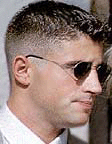 |
White Sidewalls, or White Walls, according to The Haircut
Site, refer to "the back and sides of the head when they are buzzed extremely close
to the skin, or shaved clean using lather and a razor. The newly-exposed sides of the head
are often less tan then the rest of the face, and look white (like the white on white
sidewall tires) in comparison." The photo at left is of Ryan Tripp. A
complement to this would be a "soldier's tan", also known as a "farmer's
tan" - being tanned on face and arms, but pale on shoulders, chest and back,
indicating someone spending a long time out of doors with a shirt on. |
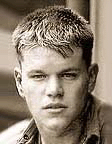 |
Finally, a "buzzcut" is, according to The Haircut
Site, a "generic name used for a variety of short clipper cuts, usually uniform in
length, where the hair conforms to the shape of the head (as opposed to a flattop). The
name comes from the sound of the electric clippers used for the cuts. A buzzcut
typically ranges from 1/2 of an inch to stubble (no guard on the clippers). Variations
include BUTCH - A Buzzcut where the hair is cut to a uniform, short length (usually 1/8
inch or less) all over. A butch would usually be considered shorter than a crewcut, and
the butch is even all over while the crewcut has a little extra length at the front of the
head. CREWCUT - A Buzzcut where the hair is clipper-cut short on the back and
sides, and to an inch or less on top." Matt Damon wore a crewcut in the movie
"Saving Private Ryan." |
 |
German haircuts during the Second World War varied from man
to man, but in general, extremely short styles were not seen (though some veterans of the
"Old Army" may have worn brushcuts). Hair tended to be cut very short on
the side (as illustrated by the White Walls cut above), but was left longer on top, often
treated with hair tonic. Commercial hair tonics like Brylcreem are still available
today.
A good source of information regarding German haircuts of
the Second World War is the film STALINGRAD which was released in 1993. The haircuts
of the principal actors capture very well some of the different styles seen in period
photos.
At left, German soldiers receive haircuts in the field. At right,
Obergefreiter Georg Ebner, photographed before his death in June 1945. |
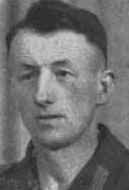 |
|
|

Even senior officers got their hair cut;
Knight's Cross holder Oberstleutnant Alfred Haase is shown at right, below - note hair
shorn almost to the skin around the ears. Haase was Commander of Pioneer Lehr
Battalion 2, and was awarded the Knights Cross by Hitler on April 1, 1942. Below
left, it can be seen that hair on top sometimes got extremely long - but always kept off
the ears and collar.
Facial Hair
Mustaches were generally not permitted in the German Army. Those that did wear
them did not let them extend past the corners of the mouth. Beards were forbidden by
regulation, except by Mountain Troops, or for medical reasons that prevented a soldier
from shaving. Even in these cases, regulations stated that beards could not exceed 2
cm in length. |
|
Piercings/Tattoos
Pierced ears were not adopted by men, generally speaking,
until the 1960s as the earliest, and did not gain widespread popularity until the
1980s. Men have always been prohibited from wearing earrings when in military
uniform. Other piercings, whether male or female, are a very recent fashion trend
and was unheard of in the 1940s or earlier.
Tattoos have gained popularity among soldiers throughout the
century. By and large, however, tattoos in the Second World War remained modest in
size and crude in design. A wide variety of other designs, non-military in nature,
could also be found. Re-enactors should cover up non-period looking tattoos with the
appropriate garments. Tattoos were usualy relegated to the arms, legs, or back by
soldiers in the first half of the 20th Century.
Tattoos and piercings did not become fashionable for women
until well after the Second World War. Piercings were generally limited to the
earlobes, one per ear on the bottom of the lobe. Earrings were to be plain metal
studs.
Eyeglasses
Eyeglasses are not commonly seen in period photos, especially
not in combat units. For those who must wear eyeglasses, acceptable styles are
limited to round wire frames, or alternately, rimless glasses.
Timepieces
Wristwatches began to be common in the first years of the
20th Century; First World War soldiers were more likely to have a pocket watch,
however. By the Second World War, wristwatches were becoming universal. Bands
were in leather or metal "twist-o-flex" and the dial was a simple one with
either Roman or Arabic numerals. Day/date features did not yet exist. Non
period watches should not be worn.
Jewellery
Wedding bands may be worn on the right hand by married
persons (this is the opposite of North American practice); otherwise it is best not to
wear jewellery with re-enactment uniform. Military regulation forbids the wearing of
any other jewellery.
Decorations
Decorations for bravery should never be worn by
re-enactors. Post-war decorations, including decorations actually earned by the
re-enactor wearing the uniform, should not be mixed with wartime attire.
Exotic Kit
Seek to portray the rule, rather than the exception.
Document your sources when you adopt a uniform, insignia or piece of equipment. One
photo of one man "somewhere in Normandy" from an unspecified unit wearing a rare
piece of equipment is generally not sufficient grounds for a re-enactor to adopt the wear
of the same piece of gear. Be specific in your research.
Don't be a "Farb"
The term "farb" has gained universal use in the
re-enactor community. It is short for "far be it from me", the usual
prologue to a detailed criticism of another re-enactor's appearance. It is now a
noun meaning "poorly turned out re-enactor" not in terms of dress and
deportment, but in historical accuracy and authenticity. Allowances are made in all
re-enactment societies and organizations. Nonetheless, the acceptable standard of
uniforms has raised considerably since the 1970s. While German re-enactors could
once get away with poorly made Swedish conversions, the standard in most groups now is
custom made reproductions. All re-enactors should strive to be as authentic as
possible in terms of uniforms and equipment, while at the same time striving to
preserve and keep safe from harm high quality, irreplaceable original items.
DEPORTMENT
While away from the field, soldiers were obligated to present
themselves as disciplined and well organized, to their superiors and to the public at
large. Soldiers were ordered (and re-enactors should seek) to follow these
guidelines of deportment:
- Outer garments such as greatcoats are either worn completely
buttoned up, or else taken off entirely.
- Hands will be kept out of pockets.
- Gum will not be chewed while in uniform.
- Headdress will be taken off when in a mess or eating
establishment, or for a church service. It will be worn at all other times,
including when driving a vehicle.
- Soldiers will not lean against walls but will instead either
sit in an appropriate place or stand erect.
- Uniforms will be kept clean and pressed; shoes and brass will
be brought to a high shine with the use of polish.
- Re-enactment uniforms should not be mixed with civilian
attire.
- Uniformed re-enactors should wear their uniforms at events,
and when in transit to/from those events ONLY. Re-enactment uniforms are not
appropriate attire for taverns or restaurants.
- Commissioned officers, whether in period uniform, or currently
serving in the Armed Forces, are to be saluted with a salute appropriate to the uniform
being worn.
- All NCOs and officers superior in rank, be they re-enactors or
currently serving members of the Armed Forces, will be addressed to either by their rank,
or (for sergeants-major and officers) as "Sir" or "Ma'am."
Public officials will be addressed by the proper form or address as well (ie "Your
Worship" for a Mayor, "Your Honour" for a Lieutenant-Governor of a
Province, "Your Highness" for a member of the Royal Family, or "Your
Majesty" for the reigning Monarch.)
- Members of foreign armed forces (whether re-enacted or
currently serving) will also be paid compliments as outlined above.
- When addressing a superior, it is customary for a soldier to
stand properly at attention
How to Talk to the Public
The main goal of re-enacting is educating people about
military history. Some tips on interacting successfully with the public at large
(including veterans):
- Thank people who pay compliments on your display or your
appearance.
- Don't argue with people who say that you have done something
wrong, even if they are incorrect.
- Don't use profanity.
- When talking to veterans, don't ask awkward questions; it is
best to stay away from the question of killing people altogether. Do not expect a
veteran to be overly interested in you until you have shown an interest in him; ask him
when he joined the Army, how long he served, what unit he was in, and questions of that
nature. Sometimes they will open up, some will not want to talk much at all.
Respect whatever decision they make in that regard. Above all, listen
to what they are saying. Do not argue with veterans, even if they appear to be wrong
about something. Be sure and thank them for their service; they will not have heard
it enough, even if they do act humble and tell you "it was only a job."
- Admit when you don't know the answer to a question. Do
NOT make something up; it may well come back to damage your credibility. Some people
enjoy asking obscure or trick questions to re-enactors out of a sense of superiority or
mischief. Admitting that you do not know everything there is to know only adds to
your professionalism. Your research may also be aided by having people tell you
things you don't know already. Be open to this.
- In general, be polite, be receptive, and remember that a
re-enactor's job is to convey his knowledge to the public, as well as be an ambassador for
the unit he is portraying.
SOME PRACTICAL
RE-ENACTING TIPS
(This article by LTC Lou Brown is reprinted from Vol. 4 Issue 4 of "Der Zug",
the newsletter of a Grossdeutschland re-enactment unit in the Eastern United States.)
Most reenactors are civilians who have never
served in the military. For that reason, there are some fundamental things, common
to almost all militaries, to which they have never been introduced. Indeed, one of
the largest tasks faced in "basic training" is to take civilian habits out of
the potential soldier. (As society becomes more "free", this becomes even
harder because the norms of the military and what is usual in society tend to become even
farther apart.) One of those things constantly reinforced in basic military
training is the proper wear of the uniform and personal appearance. Good units care
how they look and exercise considerable effort to ensure that their personnel meet
established standards. They take especial pride in ensuring the "little
things" are also looked after. One of the measures of a good unit is how its
soldiers look, especially whey they are not under close
supervision. What follows are some practical tips, adopted from my own military
experience and combined with (actual WW II) uniform practices, which will help
(re-enactors) better project the image of a solid, well-trained, and motivated unit.
(Webmasters note -
while exceptions to all of these can be seen (as illustrated by the accompanying wartime
period photos), remember that re-enactors seek to portray the rule - not the exceptions.)
Headgear is always worn outdoors.
One of the hardest things to teach a recruit is remembering to put on his cap when going
outdoors. When you leave the billets or your tent at a reenactment, be sure you
have the proper headgear, that it is properly worn, and that it is removed indoors (except
when "under arms" -- soldiers on official business who are armed do not uncover
upon entering a building.)
Items are worn, never carried.
If worn, they are worn properly.
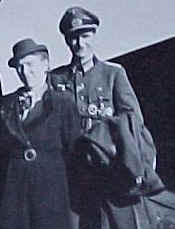 |
Soldiers don't carry overcoats, raincoats, etc., over their
arm -- the item is either worn or left behind (except, of course, as part of the field
equipment). All items are worn properly -- all buttons are buttoned, snaps done,
etc. Nothing is less military looking than someone walking around with his blouse
unbuttoned, or the cuff slits "flapping about" because he failed to ensure they
were buttoned. While many might think that such things are macho-looking, good
soldiers detest casual sloppiness; buttons are meant to be buttoned, and when they are
not, it offends the good soldier's sense of "natural order." (While highly decorated, this German
officer thinks nothing of posing for a photo with a greatcoat draped over his arm;
generally not considered appropriate, the man was probably proud of his medals (or else
the photogapher wanted a better view of them). One must always treat period photos
with suspicion; the intent of the subject and the photographer can only be guessed at,
decades after the fact.) |
Complete uniforms are always
worn. This is the corollary to the above, not the same thing.
Everything can be worn correctly, and the uniform still not be complete. While most
re-enactors get the field uniform correct, few get the German soldiers' other forms of
dress right. Off duty, low shoes and the Schirmmütze were often worn, but only in
relatively secure areas -- otherwise, the duty uniform was worn -- but this would be
entirely appropriate for wear in the cantonment area during non-battle times at
reenactments.
Soldiers generally shave once a day.
Good soldiers do not appear unshaven. Units ensure that soldiers maintain
cleanliness at all times as a matter of preserving health; part of that routine is a daily
shave. While no one would have expected the soldier to shave while bullets were
flying, part of the "after operations" cleanup would have been a return to
normal standards. Again, while some folks would find the gruff, unshaven look
"manly," a good unit would find it unacceptable.
There is no excuse for sloppiness.
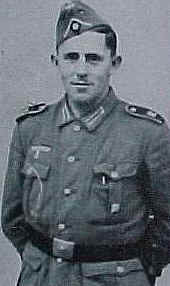 |
There is a clear difference between shoddy appearance
(brought on by aging, repaired uniforms and equipment) and sloppy appearance, which is
generally the result of neglect or lack of concern. Boots are at least blackened if
polishing is not possible, belts are worn straight (not "John Wayne" style,
drooping down over the hip), blankets are not draped around the shoulder as capes, and
uniforms and equipment are maintained as best the soldier can with what is available to
him -- missing buttons are replaced, tears carefully sewn up, etc. (Note: most
repairs....on actual....uniforms are very well done, either by being carefully hand
stitched or machine sewn. Supply personnel had sewing machines available to them
(and persons with some tailor training were generally available to conduct unit-level
repairs). Additionally, severely damaged uniforms, etc, were usually exchanged for
serviceable items -- the damaged items were then evacuated to a level where, if repair was
feasible, it was done by those who knew how to do it and the item returned to the supply
system for reissue. Generally, modern armies frown on the soldier sewing up large
tears himself -- it usually looks like hell, and, worse, doesn't hold, resulting in the
loss of the item when proper maintenance would have prevented the loss. (At left, a stuido photo of a
soldier with a pen clip clearly visible under his pocket flap - generally considered a
no-no; pens, watch chains, combs, etc., were supposed to be hidden when in uniform) |
In conclusion, there is no real
soldier in the world who hasn't been dirty, unshaven, and looked like hell at some point
-- this is not, however, the natural state. Units who allow their soldiers to go on
that way don't exist for long. Good appearance and maintenance of equipment are
habits which branch into other things -- generally, they are indicators of
discipline. Soldiers who are cavalier about correctly wearing the uniform usually
exhibit the same sort of cavalier attitude regarding the really important aspects of
soldiering -- weapons maintenance, field skills, etc. Good units are built on the
sort of discipline that results when soldiers can be trusted to do what they are supposed
to without direct supervision. Real or reenactment, you can tell a
lot about a unit when you see one of its soldiers walking down the street alone; does he
look as good as when in formation, or is he out of control? While not always true,
the old adage "if it looks good, it probably is" is at least a start point for a
better-than-average unit.
Remember, you are wearing your name on your
sleeve. |









